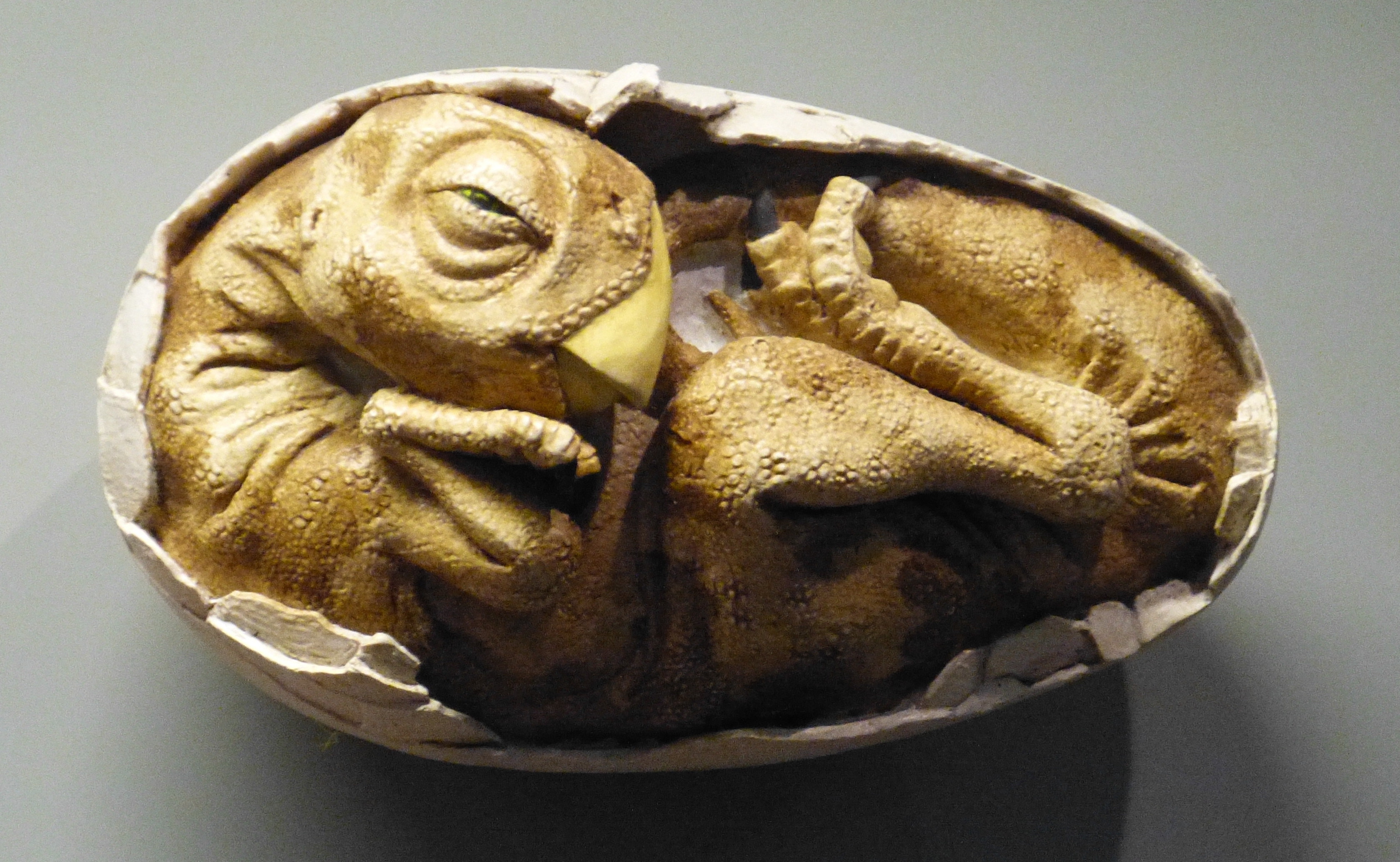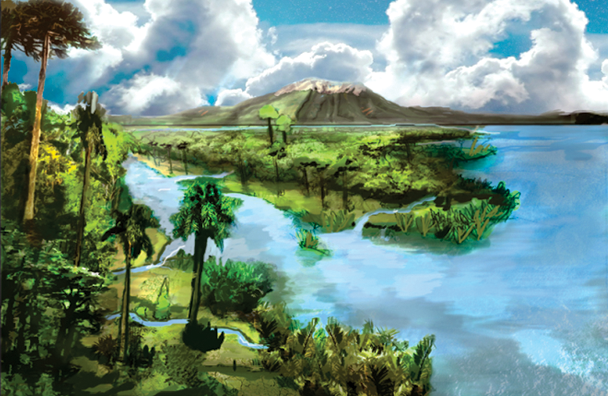|
Ellipsoolithus
''Ellipsoolithus'' is an oogenus of dinosaur egg. It contains only a single oospecies, ''E. khedaensis''. The species was found in the Upper Sandy Carbonate Member of the Lameta Formation of India. These eggs were probably laid by a theropod dinosaur.D. M. Mohabey. 1998. Systematics of Indian Upper Cretaceous dinosaur and chelonian eggshells. Journal of Vertebrate Paleontology 18(2):348-362 See also * List of dinosaur oogenera Egg fossils are the fossilized remains of eggs laid by ancient animals. As evidence of the physiological processes of an animal, egg fossils are considered a type of trace fossil. Under rare circumstances a fossil egg may preserve the remains of t ... References Bibliography * D. M. Mohabey. 1998. Systematics of Indian Upper Cretaceous dinosaur and chelonian eggshells. Journal of Vertebrate Paleontology 18(2):348-362 Elongatoolithids Dinosaur reproduction Maastrichtian life Cretaceous India Fossils of India Fossil parataxa described in 199 ... [...More Info...] [...Related Items...] OR: [Wikipedia] [Google] [Baidu] |
Oogenus
Egg fossils are the fossilized remains of eggs laid by ancient animals. As evidence of the physiological processes of an animal, egg fossils are considered a type of trace fossil. Under rare circumstances a fossil egg may preserve the remains of the once- developing embryo inside, in which case it also contains body fossils. A wide variety of different animal groups laid eggs that are now preserved in the fossil record beginning in the Paleozoic. Examples include invertebrates like ammonoids as well as vertebrates like fishes, possible amphibians, and reptiles. The latter group includes the many dinosaur eggs that have been recovered from Mesozoic strata. Since the organism responsible for laying any given egg fossil is frequently unknown, scientists classify eggs using a parallel system of taxonomy separate from but modeled after the Linnaean system. This "parataxonomy" is called ''veterovata''. History The first named oospecies was '' Oolithes bathonicae'', a name given provisi ... [...More Info...] [...Related Items...] OR: [Wikipedia] [Google] [Baidu] |
Dinosaur Egg
Dinosaur eggs are the organic vessels in which a dinosaur embryo develops. When the first scientifically documented remains of non-avian dinosaurs were being described in England during the 1820s, it was presumed that dinosaurs had laid eggs because they were reptiles. In 1859, the first scientifically documented dinosaur egg fossils were discovered in France by Jean-Jacques Poech, although they were mistaken for giant bird eggs (birds were not yet recognized as dinosaurs at the time). The first scientifically recognized non-avian dinosaur egg fossils were discovered in 1923 by an American Museum of Natural History crew in Mongolia. Dinosaur eggshell can be studied in thin section and viewed under a microscope. The interior of a dinosaur egg can be studied using CAT scans or by gradually dissolving away the shell with acid. Sometimes the egg preserves the remains of the developing embryo inside. The oldest known dinosaur eggs and embryos are from ''Massospondylus'', which lived ... [...More Info...] [...Related Items...] OR: [Wikipedia] [Google] [Baidu] |
Oospecies
Egg fossils are the fossilized remains of eggs laid by ancient animals. As evidence of the physiological processes of an animal, egg fossils are considered a type of trace fossil. Under rare circumstances a fossil egg may preserve the remains of the once- developing embryo inside, in which case it also contains body fossils. A wide variety of different animal groups laid eggs that are now preserved in the fossil record beginning in the Paleozoic. Examples include invertebrates like ammonoids as well as vertebrates like fishes, possible amphibians, and reptiles. The latter group includes the many dinosaur eggs that have been recovered from Mesozoic strata. Since the organism responsible for laying any given egg fossil is frequently unknown, scientists classify eggs using a parallel system of taxonomy separate from but modeled after the Linnaean system. This "parataxonomy" is called ''veterovata''. History The first named oospecies was '' Oolithes bathonicae'', a name given provisi ... [...More Info...] [...Related Items...] OR: [Wikipedia] [Google] [Baidu] |
List Of Dinosaur Oogenera
Egg fossils are the fossilized remains of eggs laid by ancient animals. As evidence of the physiological processes of an animal, egg fossils are considered a type of trace fossil. Under rare circumstances a fossil egg may preserve the remains of the once- developing embryo inside, in which case it also contains body fossils. A wide variety of different animal groups laid eggs that are now preserved in the fossil record beginning in the Paleozoic. Examples include invertebrates like ammonoids as well as vertebrates like fishes, possible amphibians, and reptiles. The latter group includes the many dinosaur eggs that have been recovered from Mesozoic strata. Since the organism responsible for laying any given egg fossil is frequently unknown, scientists classify eggs using a parallel system of taxonomy separate from but modeled after the Linnaean system. This "parataxonomy" is called ''veterovata''. History The first named oospecies was '' Oolithes bathonicae'', a name given provisi ... [...More Info...] [...Related Items...] OR: [Wikipedia] [Google] [Baidu] |
Maastrichtian
The Maastrichtian () is, in the ICS geologic timescale, the latest age (uppermost stage) of the Late Cretaceous Epoch or Upper Cretaceous Series, the Cretaceous Period or System, and of the Mesozoic Era or Erathem. It spanned the interval from . The Maastrichtian was preceded by the Campanian and succeeded by the Danian (part of the Paleogene and Paleocene). The Cretaceous–Paleogene extinction event (formerly known as the Cretaceous–Tertiary extinction event) occurred at the end of this age. In this mass extinction, many commonly recognized groups such as non-avian dinosaurs, plesiosaurs and mosasaurs, as well as many other lesser-known groups, died out. The cause of the extinction is most commonly linked to an asteroid about wide colliding with Earth, ending the Cretaceous. Stratigraphic definitions Definition The Maastrichtian was introduced into scientific literature by Belgian geologist André Hubert Dumont in 1849, after studying rock strata of the Chalk Group c ... [...More Info...] [...Related Items...] OR: [Wikipedia] [Google] [Baidu] |
Lameta Formation
The Lameta Formation, also known as the Infratrappean Beds, is a sedimentary geological formation found in Madhya Pradesh, Gujarat, and Maharashtra, India, associated with the Deccan Traps. It is of Maastrichtian age (Late Cretaceous), and is notable for its dinosaur fossils. Many dubious names have been created for isolated bones, but several genera of dinosaurs from these rocks are well-supported, including the titanosaur sauropod ''Isisaurus'' and the abelisaurs ''Indosaurus'', ''Indosuchus'', ''Laevisuchus'', and ''Rajasaurus''.Weishampel et al., 2004, pp.517-606 As well as mammals, snakes and other fossils. Lithology The formation is underlain by the Lower Cretaceous sedimentary "Upper Gondwana Sequence" also known as the Jabalpur Formation, and is overlain by the Deccan Traps basalt. The Lameta Formation is only exposed at the surface as small isolated outcrops associated with the Satpura Fault. The lithology of the formation, depending on the outcrop, consists of alternati ... [...More Info...] [...Related Items...] OR: [Wikipedia] [Google] [Baidu] |
Theropod
Theropoda (; ), whose members are known as theropods, is a dinosaur clade that is characterized by hollow bones and three toes and claws on each limb. Theropods are generally classed as a group of saurischian dinosaurs. They were ancestrally carnivorous, although a number of theropod groups evolved to become herbivores and omnivores. Theropods first appeared during the Carnian age of the late Triassic period 231.4 million years ago ( Ma) and included all the large terrestrial carnivores from the Early Jurassic until at least the close of the Cretaceous, about 66 Ma. In the Jurassic, birds evolved from small specialized coelurosaurian theropods, and are today represented by about 10,500 living species. Biology Diet and teeth Theropods exhibit a wide range of diets, from insectivores to herbivores and carnivores. Strict carnivory has always been considered the ancestral diet for theropods as a group, and a wider variety of diets was historically considered a characteri ... [...More Info...] [...Related Items...] OR: [Wikipedia] [Google] [Baidu] |
Dinosaur Reproduction
Dinosaur reproduction was relevant to archosaur physiology, with newborns hatching from eggs. Dinosaurs did not nurture their offspring as mammals typically do, and because dinosaurs did not nurse, it is likely that most dinosaurs were capable of surviving on their own after hatching. Medullary bone A discovery of features in a ''Tyrannosaurus rex'' skeleton provided more evidence that dinosaurs and birds evolved from a common ancestor and, for the first time, allowed paleontologists to establish the sex of a dinosaur. When laying eggs, female birds grow a special type of bone between the hard outer bone and the marrow of their limbs. This '' medullary'' bone, which is rich in calcium, is used to make eggshells. The presence of endosteally derived bone tissues lining the interior marrow cavities of portions of the ''Tyrannosaurus rex'' specimen's hind limb suggested that ''T. rex'' used similar reproductive strategies, and revealed the specimen to be female. Further research has fo ... [...More Info...] [...Related Items...] OR: [Wikipedia] [Google] [Baidu] |
Maastrichtian Life
The Maastrichtian () is, in the ICS geologic timescale, the latest age (uppermost stage) of the Late Cretaceous Epoch or Upper Cretaceous Series, the Cretaceous Period or System, and of the Mesozoic Era or Erathem. It spanned the interval from . The Maastrichtian was preceded by the Campanian and succeeded by the Danian (part of the Paleogene and Paleocene). The Cretaceous–Paleogene extinction event (formerly known as the Cretaceous–Tertiary extinction event) occurred at the end of this age. In this mass extinction, many commonly recognized groups such as non-avian dinosaurs, plesiosaurs and mosasaurs, as well as many other lesser-known groups, died out. The cause of the extinction is most commonly linked to an asteroid about wide colliding with Earth, ending the Cretaceous. Stratigraphic definitions Definition The Maastrichtian was introduced into scientific literature by Belgian geologist André Hubert Dumont in 1849, after studying rock strata of the Chalk Gr ... [...More Info...] [...Related Items...] OR: [Wikipedia] [Google] [Baidu] |
Cretaceous India
The Cretaceous ( ) is a geological period that lasted from about 145 to 66 million years ago (Mya). It is the third and final period of the Mesozoic Era, as well as the longest. At around 79 million years, it is the longest geological period of the entire Phanerozoic. The name is derived from the Latin ''creta'', "chalk", which is abundant in the latter half of the period. It is usually abbreviated K, for its German translation ''Kreide''. The Cretaceous was a period with a relatively warm climate, resulting in high eustatic sea levels that created numerous shallow inland seas. These oceans and seas were populated with now-extinct marine reptiles, ammonites, and rudists, while dinosaurs continued to dominate on land. The world was ice free, and forests extended to the poles. During this time, new groups of mammals and birds appeared. During the Early Cretaceous, flowering plants appeared and began to rapidly diversify, becoming the dominant group of plants across the Earth by the ... [...More Info...] [...Related Items...] OR: [Wikipedia] [Google] [Baidu] |
Fossils Of India
A fossil (from Classical Latin , ) is any preserved remains, impression, or trace of any once-living thing from a past geological age. Examples include bones, shells, exoskeletons, stone imprints of animals or microbes, objects preserved in amber, hair, petrified wood and DNA remnants. The totality of fossils is known as the ''fossil record''. Paleontology is the study of fossils: their age, method of formation, and evolutionary significance. Specimens are usually considered to be fossils if they are over 10,000 years old. The oldest fossils are around 3.48 billion years old to 4.1 billion years old. Early edition, published online before print. The observation in the 19th century that certain fossils were associated with certain rock strata led to the recognition of a geological timescale and the relative ages of different fossils. The development of radiometric dating techniques in the early 20th century allowed scientists to quantitatively measure the absolut ... [...More Info...] [...Related Items...] OR: [Wikipedia] [Google] [Baidu] |

.jpg)





